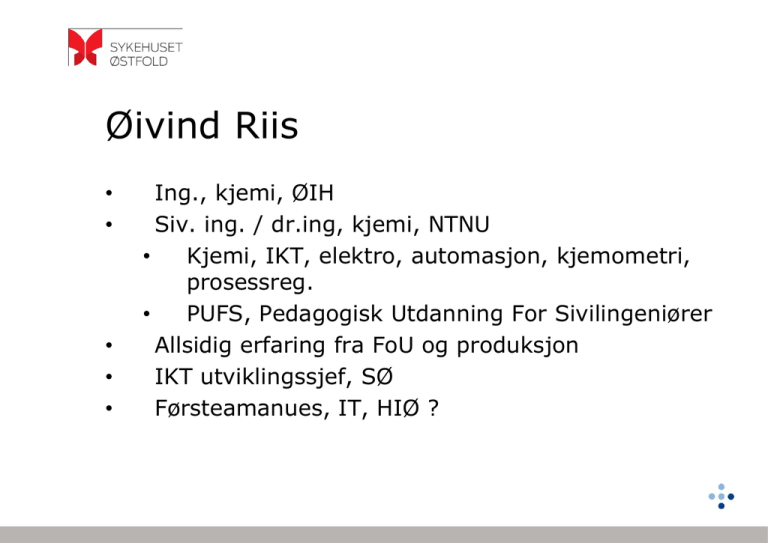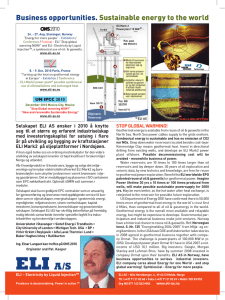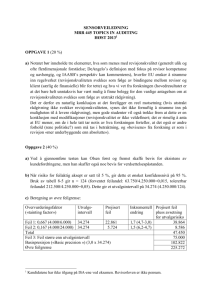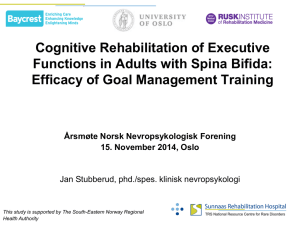Styrt produksjon av helsetjenester
advertisement

Øivind Riis • • • • • Ing., kjemi, ØIH Siv. ing. / dr.ing, kjemi, NTNU • Kjemi, IKT, elektro, automasjon, kjemometri, prosessreg. • PUFS, Pedagogisk Utdanning For Sivilingeniører Allsidig erfaring fra FoU og produksjon IKT utviklingssjef, SØ Førsteamanues, IT, HIØ ? Styrt produksjon av helsetjenetser • Behov for styrt produksjon også av helsetjenetser? • Mer industrielt pregede rammebetingelser • • • • • ISO sertifisering av akuttmottaket Lean NØS: jevn god og dokumentert kvalitet med mindre kostnader Behandlingslinjer Verdi konfigurasjoner • kjede • verksted • nettverk Styrt produksjon av helsetjenetser • Produksjonsplanlegging (ulike tidshorisonter) som balanserer hensyn til medisinsk kvalitet, økonomi og effektivtet. Multikriteriaoptimalsiering. Styrt produksjon av helsetjenetser • • • • SØ og Prediktor har ”verifisert” konseptet (bruk av MES / Ind IT for å oppnå styrt produksjon av helsetjenester) gjennom OFU prosjektet CAPAS ”Nytt” område innen helse/helsetjeneste forskning hvor HIØ / SØ /Østfold i samarbeid med nasjonale /internasjonal aktører kan innta en fremtredende /ledende rolle innen definerte områder. Involverer de fleste profesjoner i helsevesenet og dermed ulike fag ved HIØ Kan involvere ulike offentlige og private aktører i Østfold. HIØ blir nav og kompetanse senter? Styrt produksjon av helsetjenetser • HIØ / SØ / ++ kan relativt raskt etablere tverrfaglige praktiske og teoretiske prosjekter på alle fagnivåer ved å bygge videre på realisering av styrt produksjon basert på Industriell IT og Process Analytival Technology og evt. CAPAS pilotene Styrt produksjon av helsetjenetser • Basert på bl.a. • PAT, Process Analytical Technology • Evt annen kvalitets-/styrings-/forbedrings filsofi Industriell IT Automasjonspyramiden • • • HL7, DICOM, OPC UA, ISA 95, ISA 88 etc Eget eid / forvaltet utvidet tverrfaglig journal. • • Strukturerte maskinleselige data. Open EHR? Process Analytical Technology, PAT The goal of PAT according to the U.S. Food and Drug Administration, FDA, is to understand and control the manufacturing process, which is consistent with our current drug quality system: quality cannot be tested into products; it should be builtin or should be by design. Process Analytical Technology, PAT FDA provides the following recomadantions for achieving the goal as described above: Process Analytical Technology is: a system for designing, analyzing, and controlling manufacturing through timely measurements (i.e., during processing) of critical quality and performance attributes of raw and in-process materials and processes with the goal of ensuring final product quality. It is important to note that the term analytical in PAT is viewed broadly to include chemical, physical, microbiological, mathematical, and risk analysis conducted in an integrated manner. Process Analytical Technology, PAT FDA provides the following recomadantions for achieving the goal as described above: Process Analytical Technology tools: There are many current and new tools available that enable scientific, risk-managed pharmaceutical development, manufacture, and quality assurance. These tools, when used within a system can t means for acquiring information to provide effective and efficient facilitate process understanding, develop risk-mitigation strategies, achieve continuous improvement, and share information and knowledge. In the PAT framework, these tools can be categorized as: – Multivariate data acquisition and analysis tools – Modern process analyzers or process analytical chemistry tools – Process and endpoint monitoring and control tools – Continuous improvement and knowledge management tools An appropriate combination of some, or all, of these tools may be applicable to a single-unit operation, or to an entire manufacturing process and its quality assurance. Process Analytical Technology, PAT FDA provides the following recomadantions for achieving the goal as described above: A desired goal of the PAT framework is to design and develop processes that can consistently ensure a predefined quality at the end of the manufacturing process. Such procedures would be consistent with the basic tenet of quality by design and could reduce risks to quality and regulatory concerns while improving efficiency. Gains in quality, safety and/or efficiency will vary depending on the product and are likely to come from: Reducing production cycle times by using on-, in-, and/or at-line measurements and controls. Preventing rejects, scrap, and re-processing. Considering the possibility of real time release. Increasing automation to improve operator safety and reduce human error. Facilitating continuous processing to improve efficiency and manage variability Ind IT Konseptrapport, NØS Sitat: Den fysiske infrastrukturen og de funksjoner som skal legges inn for IKT-anleggene ved nytt østfoldsykehus skal forankres i til enhver tid gjeldende IKT-strategi for Sykehuset Østfold og for Helse Sør Øst. ”Industriell IKT” må understøttes. Data skal kunne innhentes uavhengig av datakilde (EKG, CT, MR, etc). Alt driftsteknisk, MTU og IKT-utstyr skal kunne nås via datanettet. Sitat slutt Statoil, Knut Tungland We define Industrial IT as information and technology designed to link industrial equipment, systems and processes together in real time. This means: Industrial IT solutions are used to collect, monitor and present data from process control and other real time systems in the plants, and to provide data transport between process controls, production reporting and ERP systems in a seamless manner. Industrial BI • • • • • • Industriell BI Erling Fledsberg, Prediktor Industriell BI Espen Krogh, Prediktor Industriell BI Hans Marius With, SPT Group Industriell BI Jan Stubstad, Kongsberg Industriell BI Knut Tungland, Statoil Industriell BI Steinar Sælid, PrediktorIndustriell BI Terje Karstang, Prediktor Automasjonspyramiden Aktiviteter stilling, IKT, HIØ • Arbeide innen ”Styrt produksjon av helsetjenester” basert på PAT / Industriell IT /automasjonspyramiden • Bidra til en bedre tilpasset utdanning • • • Delta i utarbeidelse av fagplaner Undervisning og prosjekter innen omtalte fagområpder Helse/helsetjenesteforskning


